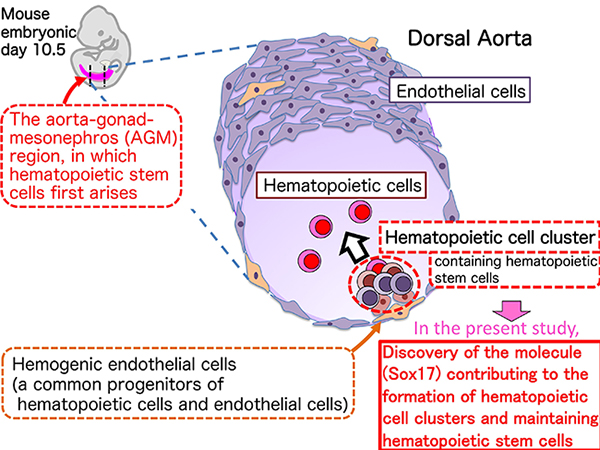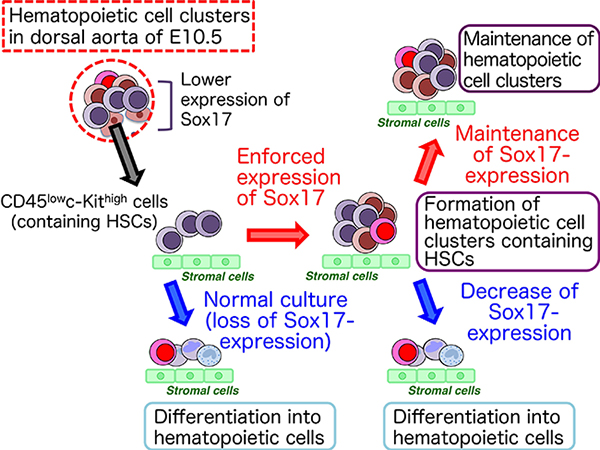“Discovery of the molecule Sox17 to maintain the hematopoietic stem cell at embryonic stages”
Points
| 1. | During mouse development, hematopoietic stem cells (HSCs) initially arise in the hematopoietic cell clusters attached to the inside wall of the dorsal aorta at midgestation. However, it is not known what mechanism is employed to maintain the HSCs in the hematopoietic cell clusters. |
| 2. | In this study, forced expression in vitro of a transcription factor Sox17 in the major cells comprising the intra-aortic cell clusters led to repetitive formation of cell clusters during several passages of cocultures with stromal cells. Moreover, HSCs were maintained in Sox17-transduced hematopoietic cell clusters. |
| 3. | The results raise the possibility of developing novel approaches to effectively maintain the HSCs in vitro. |

Figure 1 Hematopoietic cells clusters containing hematopoietic stem cells
Professor Tetsuya Taga and associated professor Ikuo Nobuhisa, Department of Stem Cell Regulation, Medical Research Institute, Tokyo Medical and Dental University (TMDU) in collaboration with Chiba University, University of Tokyo, and Kumamoto University have discovered the molecule to maintain the HSC from mouse embryos. This work was supported by grants from the Ministry of Education, Culture, Sports, Science and Technology of Japan, CREST, JST, the Takeda Science Foundation, and the Joint Usage/Research Project of the Medical Research Institute, Tokyo Medical and Dental University. The present study was published in Molecular and Cellular Biology on June 1, 2014.
Background
HSCs that are source of all hematopoietic cells exist in bone marrow of adult mice. During mouse development, HSCs initially arise in hematopoietic cell clusters which are attached to the inside wall of the dorsal aorta at midgestation and are produced from the hemogenic endothelial cells (a common progenitors of hematopoietic cells and endothelial cells). Runx1 (a transcription factor essential for hematopoiesis)-deficient mice could not develop hematopoietic cell clusters in the dorsal aorta of the midgestational mouse embryo. However, it is not known exactly how HSCs are maintained in the hematopoietic cell clusters.
Main findings and significance of this study
When cells of the hematopoietic cell clusters attached to the inside wall of the dorsal aorta at midgestation were cocultured with stromal cells, the expression level of Sox17 in the cells was decreased and the differentiation of the cells into hematopoietic cells (granulocytes and macrophages) was found. Here we show that forced expression of Sox17 in the major cells comprising the hematopoietic cell clusters, led to consistent formation of cell clusters and maintenance of multipotency in vitro during several passages of cocultures with stromal cells. A Sox17-point mutant that is defective for binding to DNA loses the ability of forming the hematopoietic cell cluster and maintaining the undifferentiated state in vitro. The results suggest that the transcriptional activity of Sox17 is essential for the formation of cell cluster and the maintenance of the hematopoietic potential. Shutdown of the exogenously transduced Sox17 gene expression in the Sox17-transduced cell clusters resulted in the differentiation into hematopoietic cells (granulocytes and macrophages) in the cocultures with stromal cells. The data indicated that, in the hematopoietic cell cluster, a sustained expression of Sox17 contributed the maintenance of multipotency, whereas a downregulation of the expression of Sox17 led to the hematopoietic differentiation. Moreover, intra-bone marrow transplantation of the Sox17-transduced cells into irradiated mice revealed that hematopoietic cells were repopulated over a relatively long period. These results indicated that Sox17-transduced cells maintained the HSCs. Our results suggest that Sox17 plays a pivotal role in controlling the HSC fate decision between indefinite self-renewal and differentiation during fetal hematopoiesis. It has recently been reported that introduction of Sox17 into these adult HSC, which do not express Sox17, leads to the maintenance of their stem cell activity for the long time. Our results raise the possibility of developing novel approaches to effectively maintain the HSCs in vitro.

Figure 2 Forced expression of Sox17 in the major cells comprising hematopoietic cell clusters led to formation of the clusters containing HSCs
Correspondence to:
Tetsuya TAGA, Professor, Ph.D. and Ikuo Nobuhisa, Ph.D., Associate Professor
Department of Stem Cell Regulation
Medical Research Institute, Tokyo Medical and Dental University (TMDU)
1-5-45, Yushima, Bunkyo-ku, Tokyo, 113-8510
E-mail: taga.scr(at)mri.tmd.ac,jp (TT) and nobuhisa.scr(at)mri.tmd.ac.jp (IN)
*Please change (at) in the e-mail addresses to @ when sending correspondence.
Department of Stem Cell Regulation
Medical Research Institute, Tokyo Medical and Dental University (TMDU)
1-5-45, Yushima, Bunkyo-ku, Tokyo, 113-8510
E-mail: taga.scr(at)mri.tmd.ac,jp (TT) and nobuhisa.scr(at)mri.tmd.ac.jp (IN)
*Please change (at) in the e-mail addresses to @ when sending correspondence.

